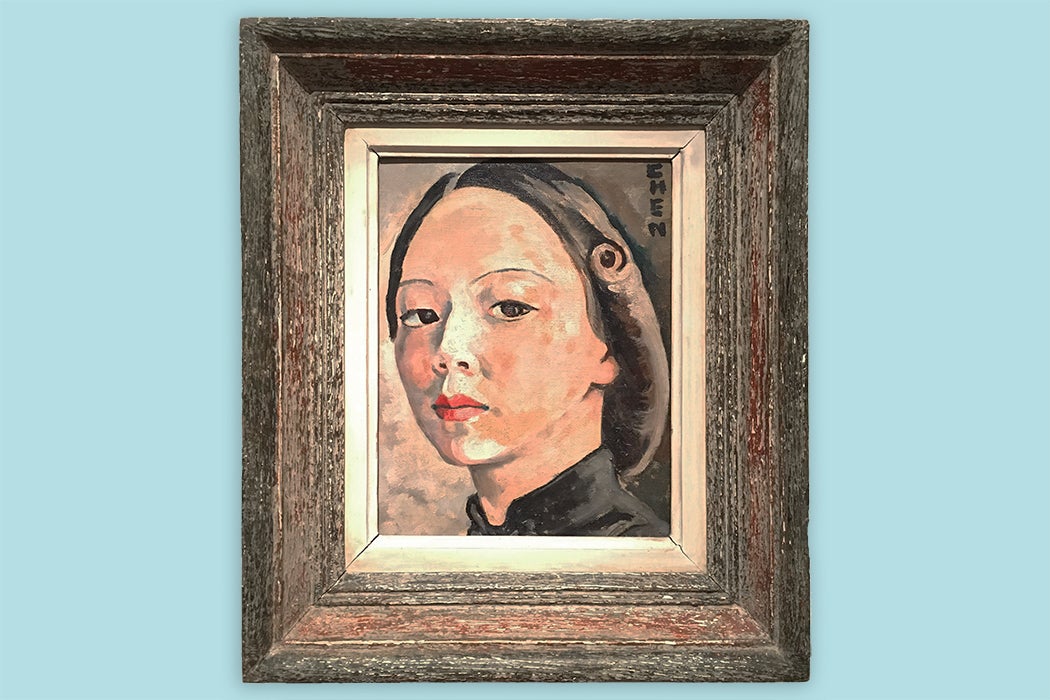In a work that journalist Ong Sor Fern calls “perhaps the most famous image of Georgette Chen,” the painter “gazes directly at the viewer with a severe, even confrontational air. […] There is a distinct sense in this portrait that this is a self-contained woman, aware of her own worth and clear in her purpose.”
Indeed, Chen is “arguably the most influential woman artist in Singapore,” according to arts educator Jane Chia.
Born Chang Yi Ling in 1906 in China, Chen traveled frequently between China and Paris as a child and attended high school in the United States. In 1926, she studied in the Art Students League of New York in 1926; between 1927 and 1931, she studied in Paris. In 1930, she exhibited a view of the Seine in the Salon d’Automne. She moved to Singapore after World War II and became involved with the artistic movement that came to be known as “Nanyang style.” Nanyang-style artists like Chen are known for merging European techniques with Southeast Asian inspiration.
“All of her signed works bear the name ‘Chen,’ which was an adaptation of her chosen nom de plume…a derivation of the Sanskrit word Chendana, meaning sandalwood,” Chia explains. “This…may seem an unexpected choice for a Chinese woman painter; but the name…may have been chosen to symbolize her putting down roots in Singapore. Selecting a tree native to the tropics was part of that signifying play.”
Chen developed a reputation for her still-life oeuvre, which “became transformed in her work once she began to live in Singapore as it was influenced by her tropical surroundings.”
Notably, she kept a collection of local baskets, which make an appearance—stuffed with tropical produce and other foodstuffs—in her still-life paintings. Originally a European tradition, the still life offered Chen a means to communicate her “particular environment” to the viewer.
“Some of this work is anecdotal and symbolic in content such as the canvases which show objects of recognizably culturally-based significance such as lanterns and mooncakes,” Chia writes. “She rejected objets de luxe for her still-life compositions in favor of the familiar, commonplace objects of her Asian context.”
Chen “lived through times of upheaval” and had been married to Sun Yat-Sen’s foreign minister Eugene Chen until his wartime death. Unlike in the work of Chen’s revolutionary peers in post-war Malaya, however, Chia finds no trace of political commentary in her art. Suggesting that Chen was an artist who “view[s] events extraneous to themselves as inconsequential in the main,” Chia speculates that “perhaps her move to Singapore was also a new beginning in this sense too, one where politics and cataclysmic events would not be allowed to intrude.”
Chia’s article in Feminist Studies was published in 1999. At the time, Singaporean women artists were still often overlooked.
“In Singapore the undervaluing and marginalizing of women’s art is a result of women’s limited access to educational opportunities and art training,” Chia argues. Under these circumstances, Chen, despite her achievements, “continues to be omitted from the roll of honor.”
Weekly Newsletter
Still, the art world’s efforts to recover and showcase Chen’s work have paid off. More than two decades later, the National Gallery Singapore would stage a major survey of Chen’s works in 2020, in a retrospective called “Georgette Chen: At Home in the World.” Exhibition materials describe her as “a key figure in the development of modern art in Singapore, widely recognized for her achievements as an artist and contributions as an educator.”
Today, it’s not only Chen who is “aware of her own worth.” The recent reexamination of her life and work showcases the talent and unique perspectives she brought to the world of art from China and Singapore to New York and Paris.
Support JSTOR Daily! Join our membership program on Patreon today.







